Click on the link below to go to our new site.
The silly humans spent money on a yachtblogs site and now the new owners are shutting the site down. Shows you what I have to deal with here.
Click on the link below to go to our new site.
The silly humans spent money on a yachtblogs site and now the new owners are shutting the site down. Shows you what I have to deal with here.
Sorry guys, but we are unsure how long yachtblogs.com will be running.
I got the humans to purchase me the domain spiritofargo.com and I am putting the blog on it instead.
Click on the link below and it will send you there.
Quinney Quinnster Productions proudly presents:
Sailing with aquatic mammals; enjoy
Rolly crossing; do not watch this if you have a weak stomach!
Video never captures things well, but we hope that gave you a little idea.
Sorry for the delay everyone.
Here are some pictures of the crossing…….hope you enjoy!
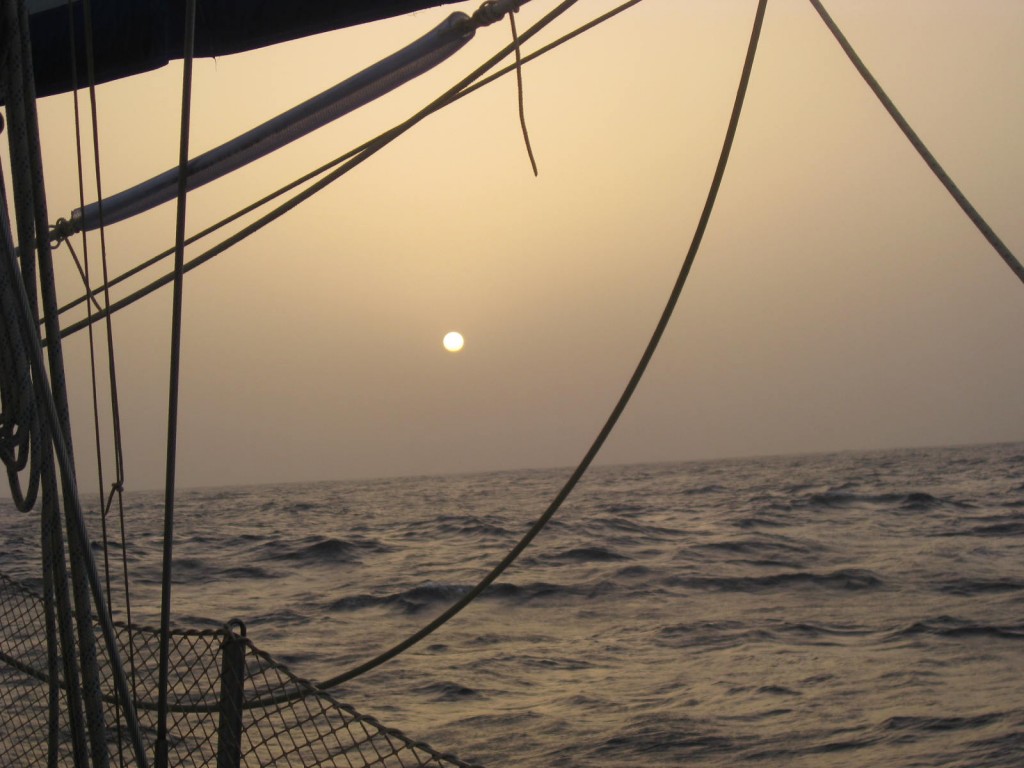
Day 4
Now we are sailing through the Sahara sands.
Many things on the boat are still died red from the sand.
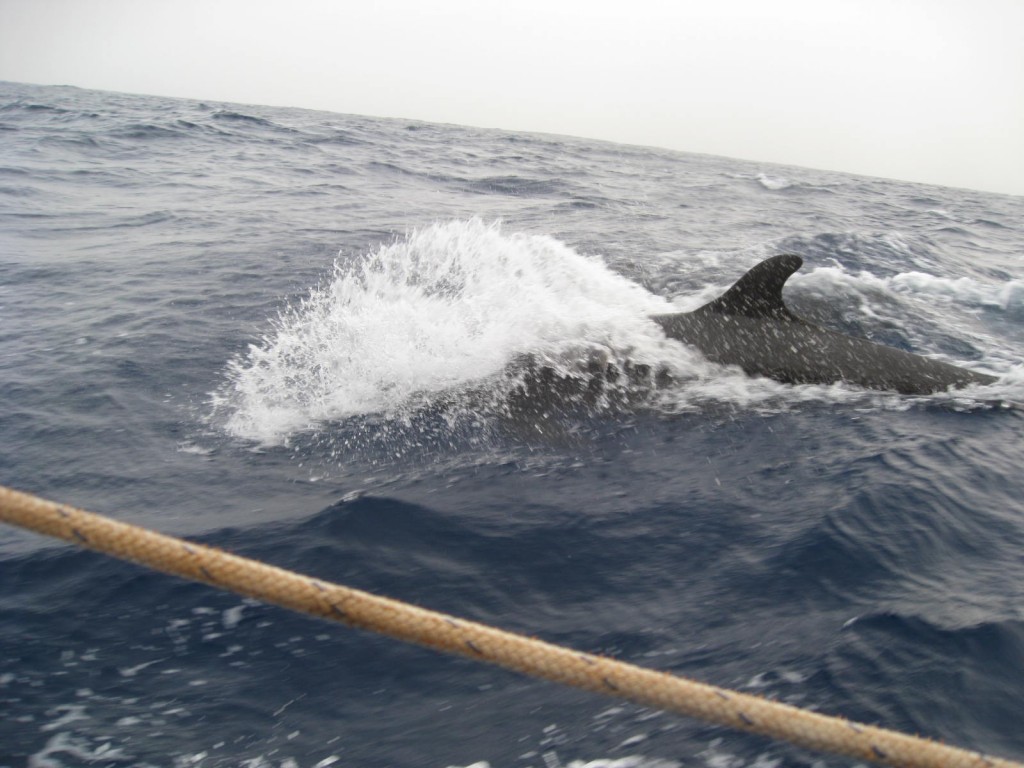
Day 7
Our morning whale visit.
You could hear them singing when you went below decks.
Do not worry, if you are a whale lover, video to follow!
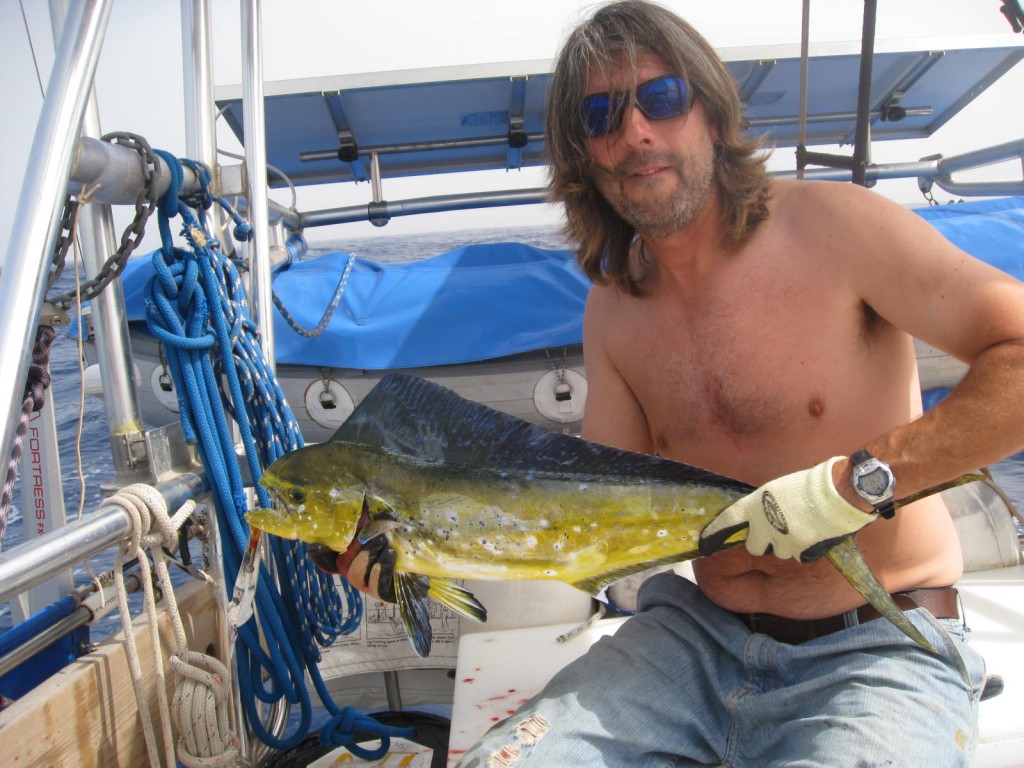
Day 7
Then the fishing really turned on. We got several tuna and Dorado including this nice 6 lb fish.
Too bad they loose their brilliant blue fin colour once they are landed.
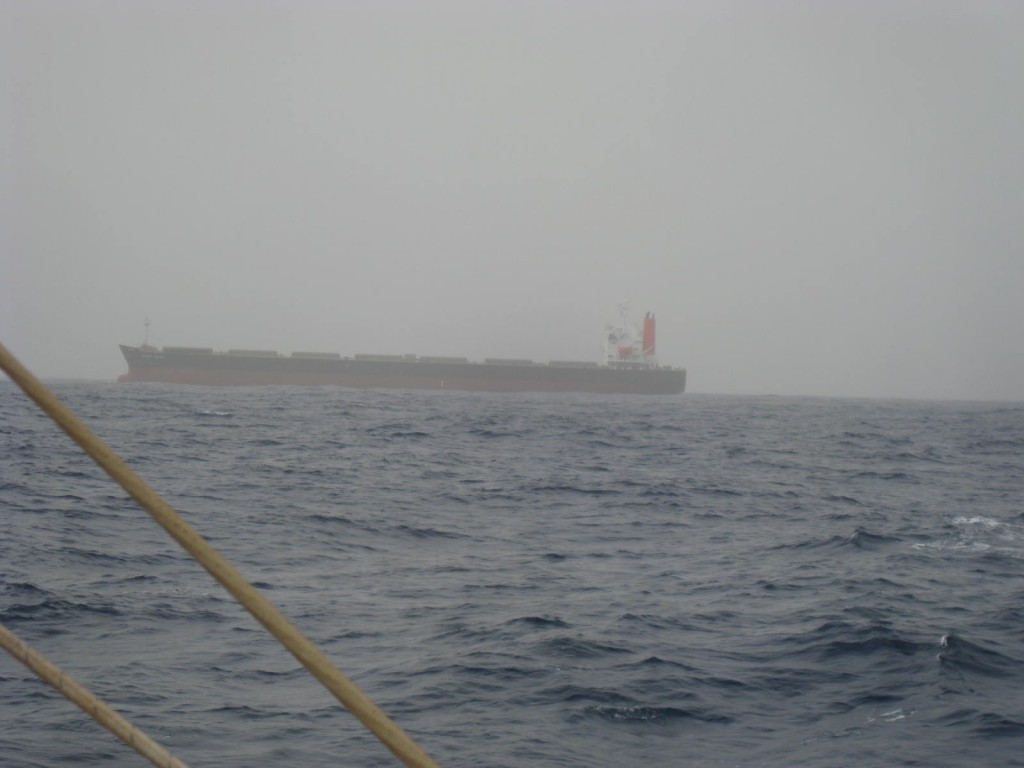
Day 7
Then this ship came out of the sandy mist and we had to wake them up so they could alter course around us.
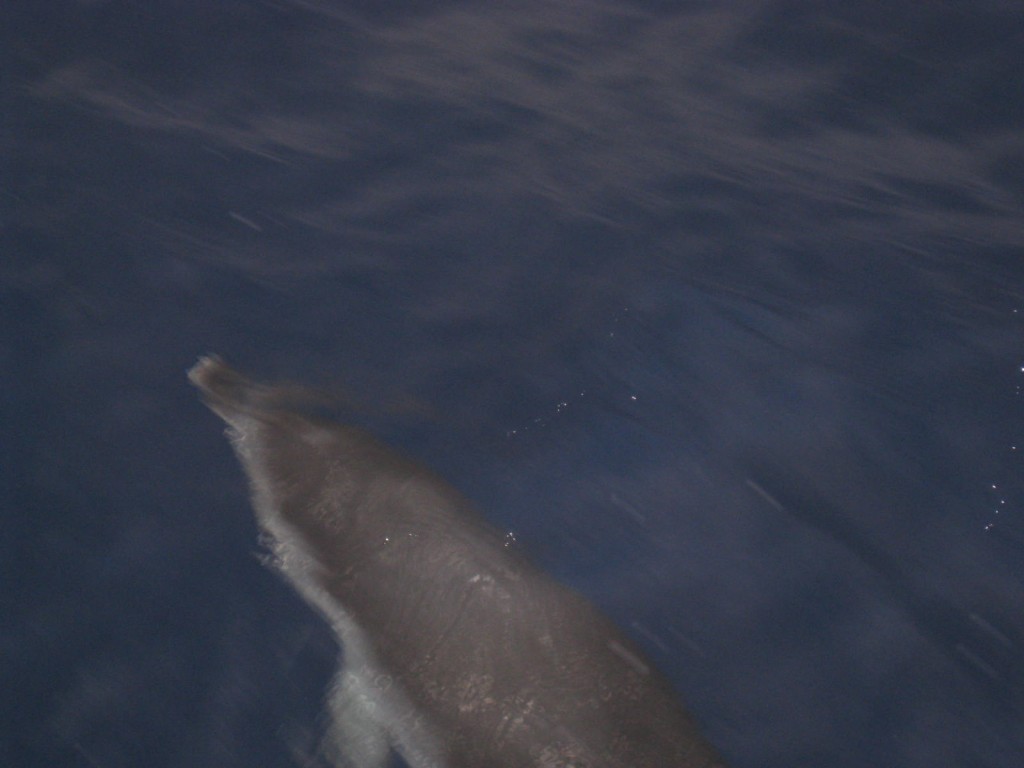
Day 7
Atlantic Spotted dolphin
We had a couple of visits along the crossing. Do not worry dolphin lovers, video on the way!
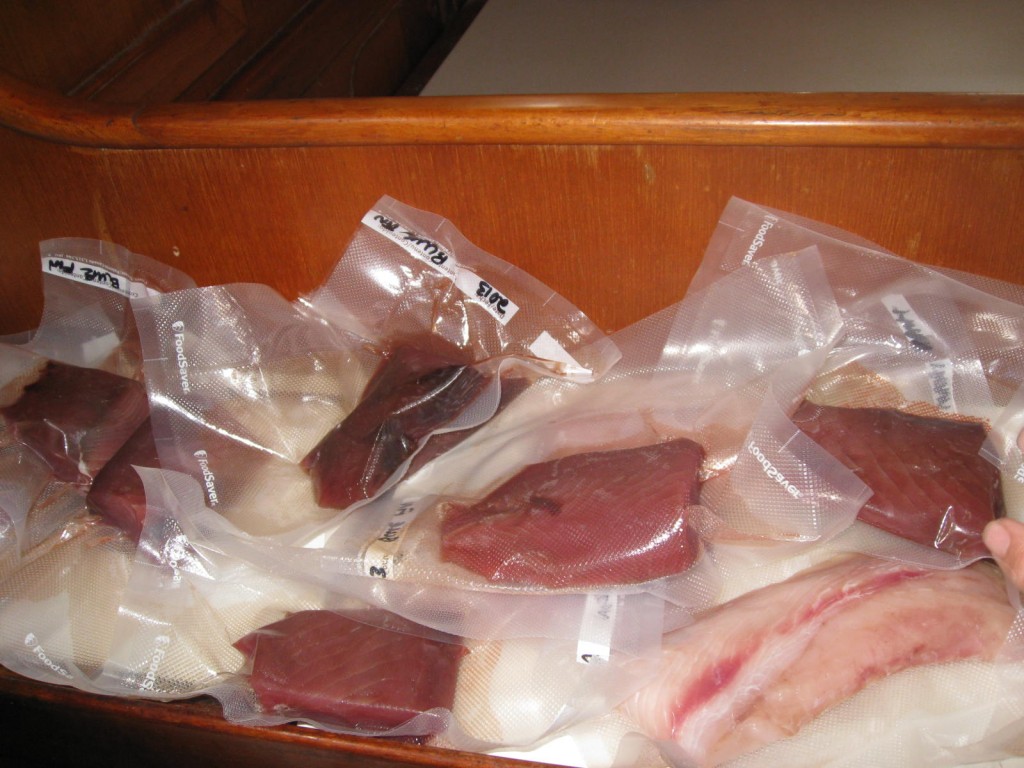
Day 8
We filed ourselves on fish and then used our 12V vacuum packer to seal up the rest for our little freezer. It will not last long!
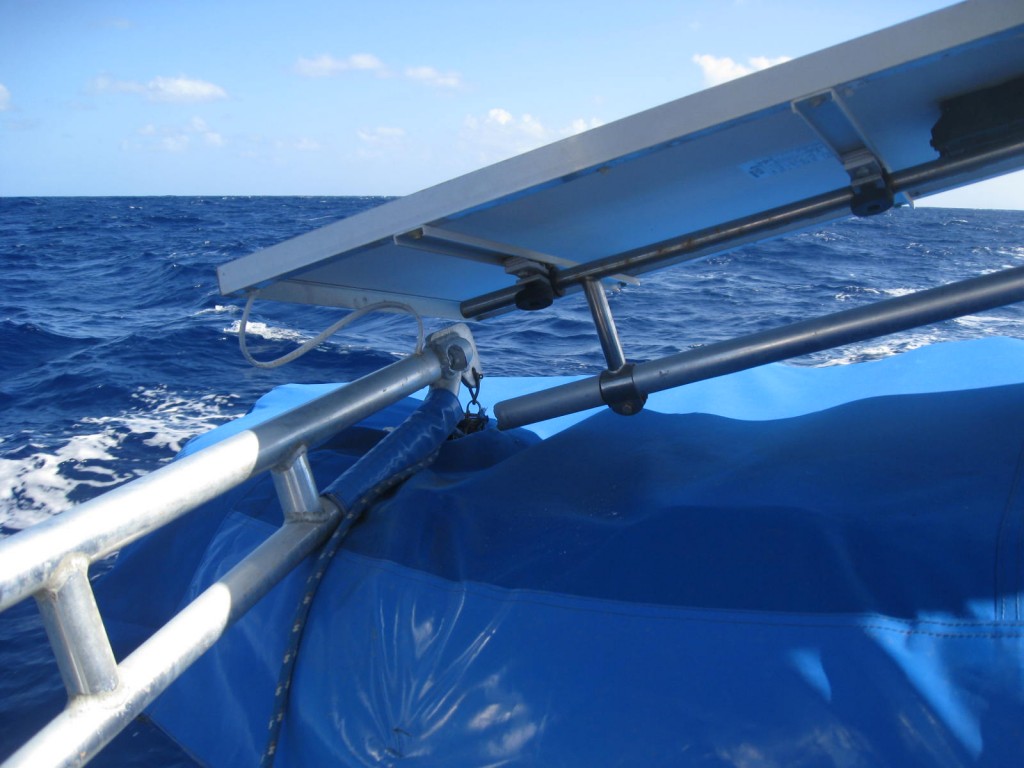
Day 10
The davits broke. The cross bar that supports the solar panels could not take the violent rolling any more.
After that it was A LOT OF OPEN SEA!
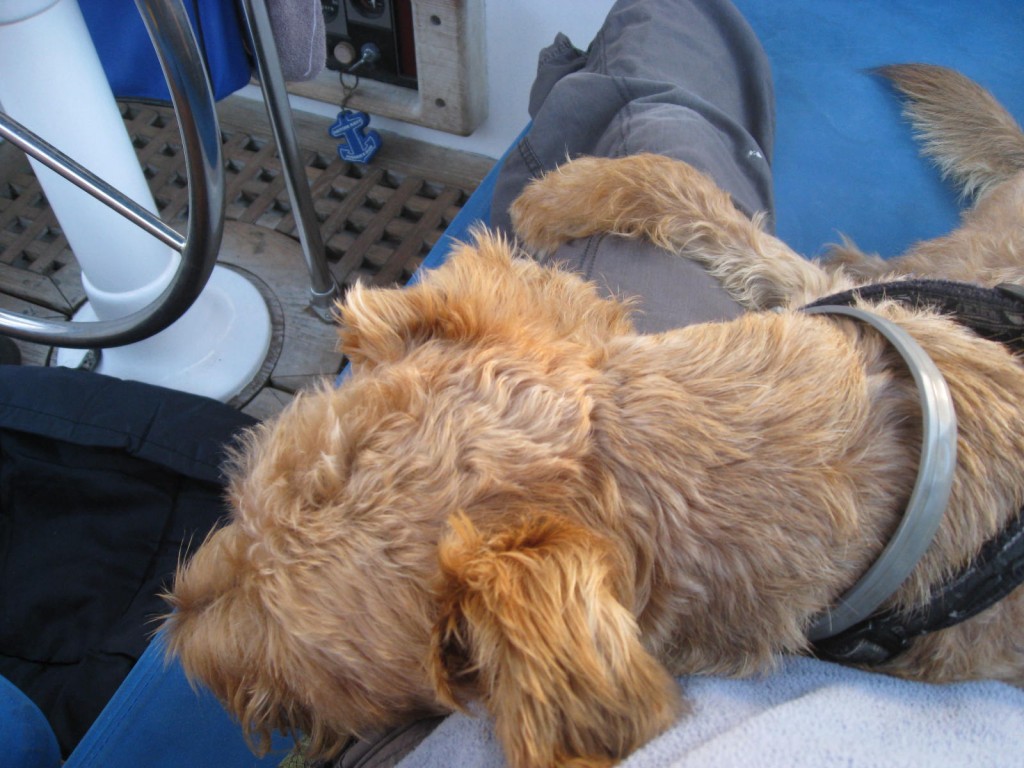
Day 12
Not a lot to do at sea.
The human’s had to take turns letting me sleep on their laps because the boat was too rolly for me to stay on the cockpit seats alone.
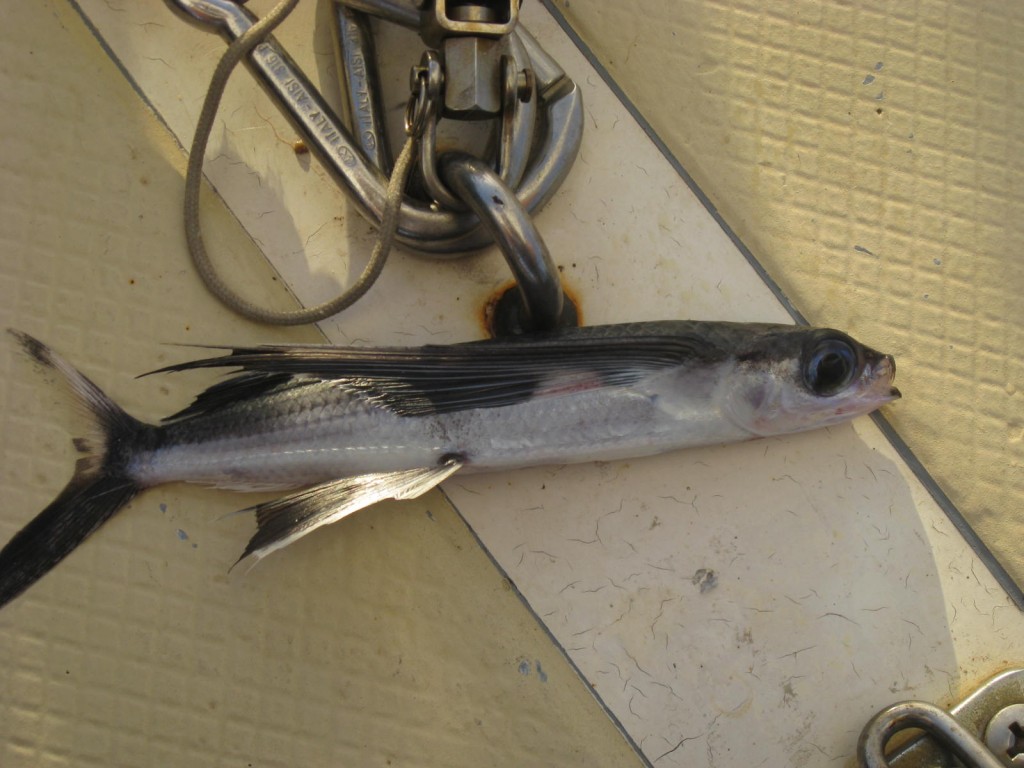
Day 13
The flying fish occasionally broke up the monotony by launching them selves over our mesh guard rails.
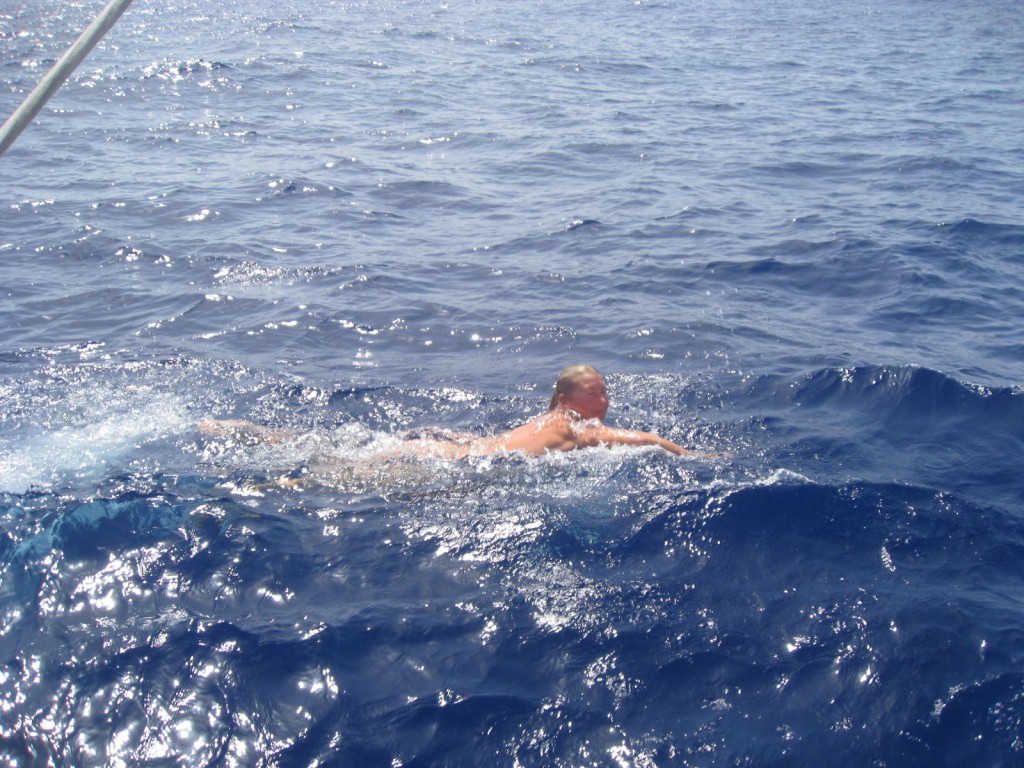
Day 15
Do not try this at home kids!
Remember to fix a long drape line to the boat if you go for a swim at sea. With all the sails down we still had a 2 knot drift. You had to swim hard to keep up with the boat.
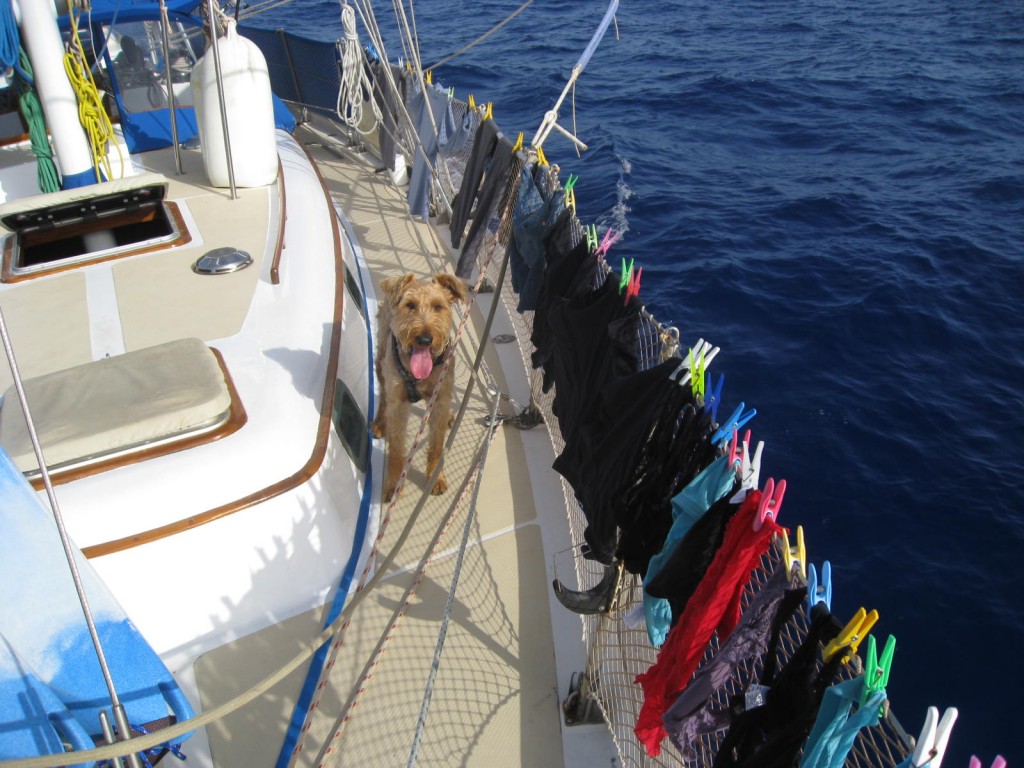
Day 15
If you have no wind to sail….you might as well do a little laundry. Wash and rinse in salt water followed by a final fresh water rinse.
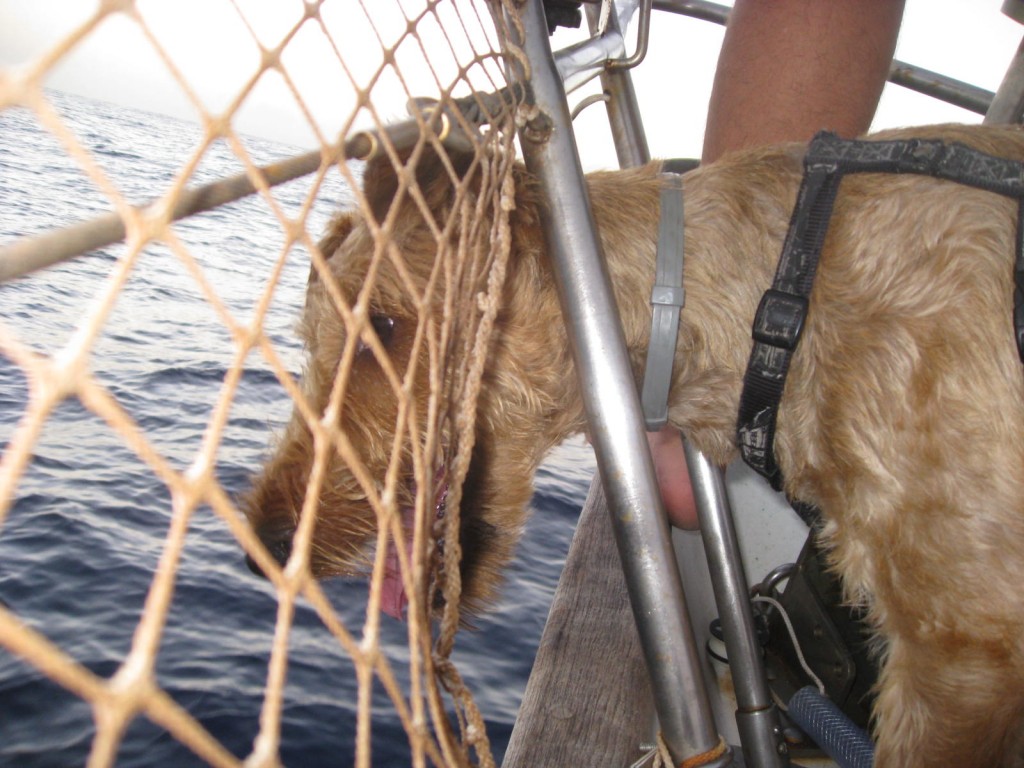
Day 16
Me barking at the dolphins. They like to play around the bow, and it is my job to keep them in their place.
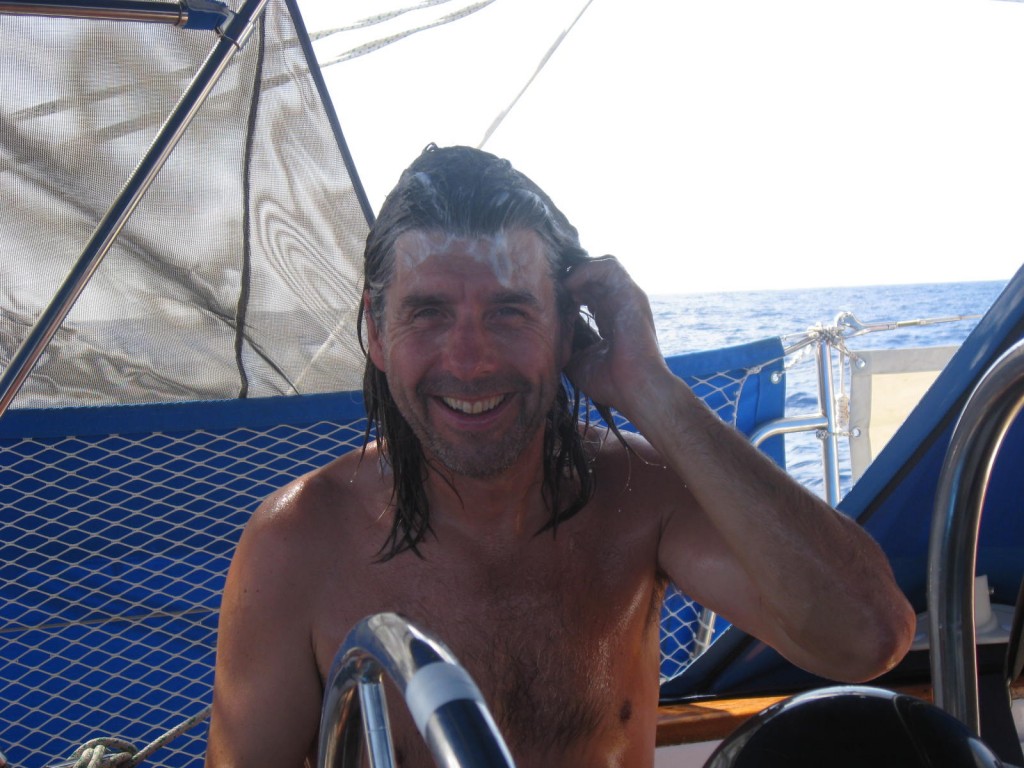
Day 17
We were very glad we fitted a cockpit shower and very lucky we had enough fresh water to have regular washes. The mesh side screen, in the back ground, really helped to keep the sun off but allowed the breeze through.
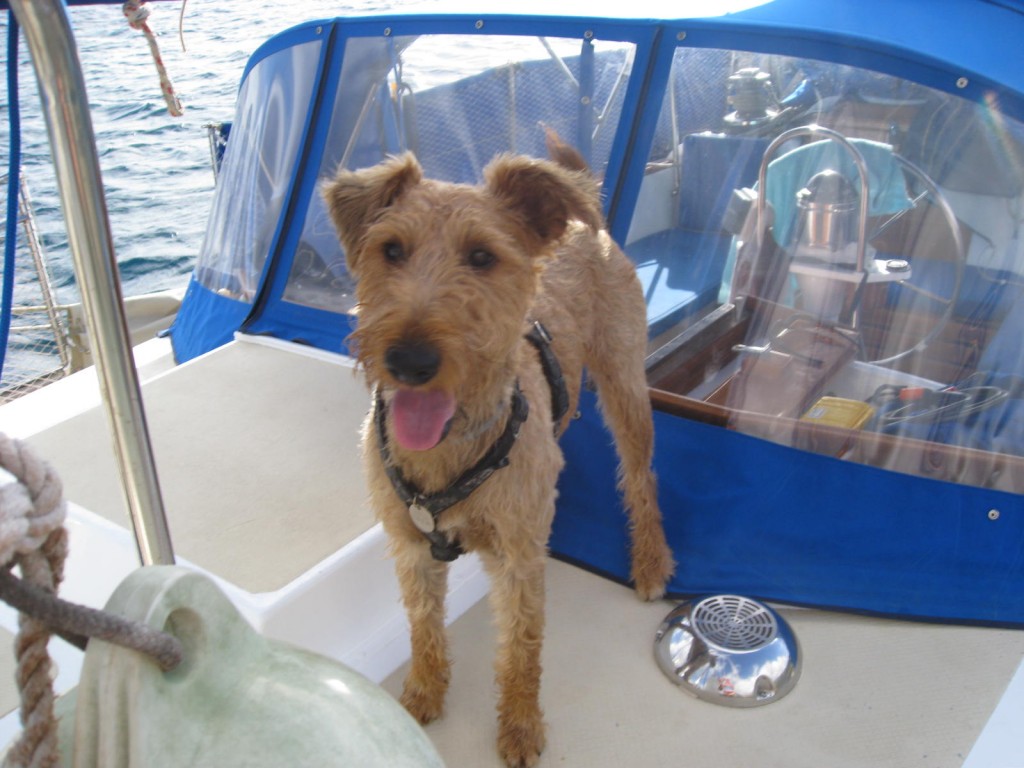
Day 21
You could smell land all night, then a glow and finally the islands lights. By dawn we could see it’s shores.
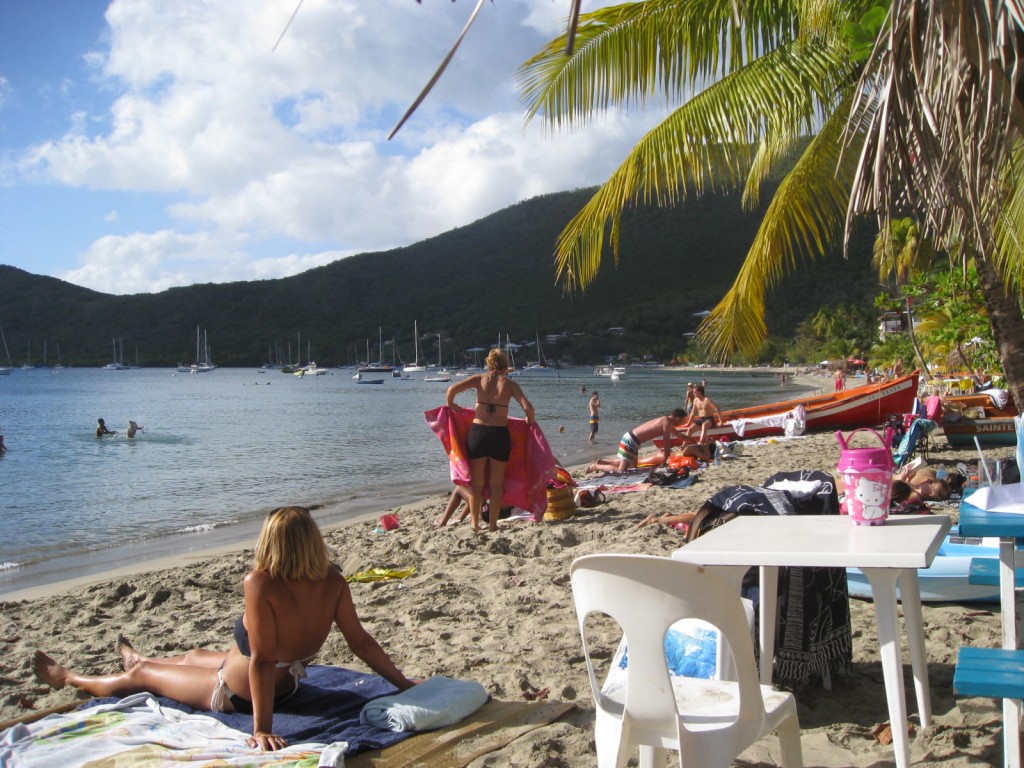
Day 21
The beach had a ‘dingy’ dock and we all went ashore to check in.
No officials. Just a computer in the back of the first bar. Very trusting.
Here is a picture of the beach with the anchorage off to one side.
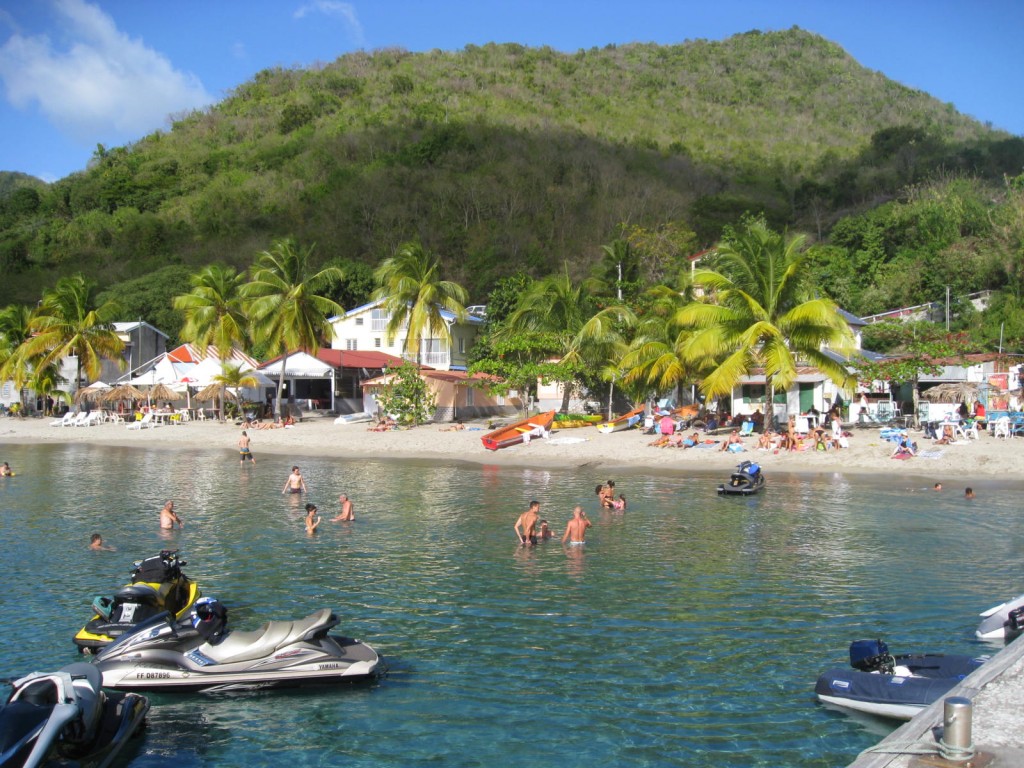
Day 21
View of the beach form the dingy dock. Not a wide beach, but they have almost no tide here. We arrived on the weekend, so the beach was very busy.
I am sifting and slicing tones of video.
I got whales, I got dolphins and of course I got rolly seas. Quinney Quinnster Productions will have them up ASAP.
For fellow sailors, here are some informational shots of the twin head sail arrangement. You will get better views when the video is up.
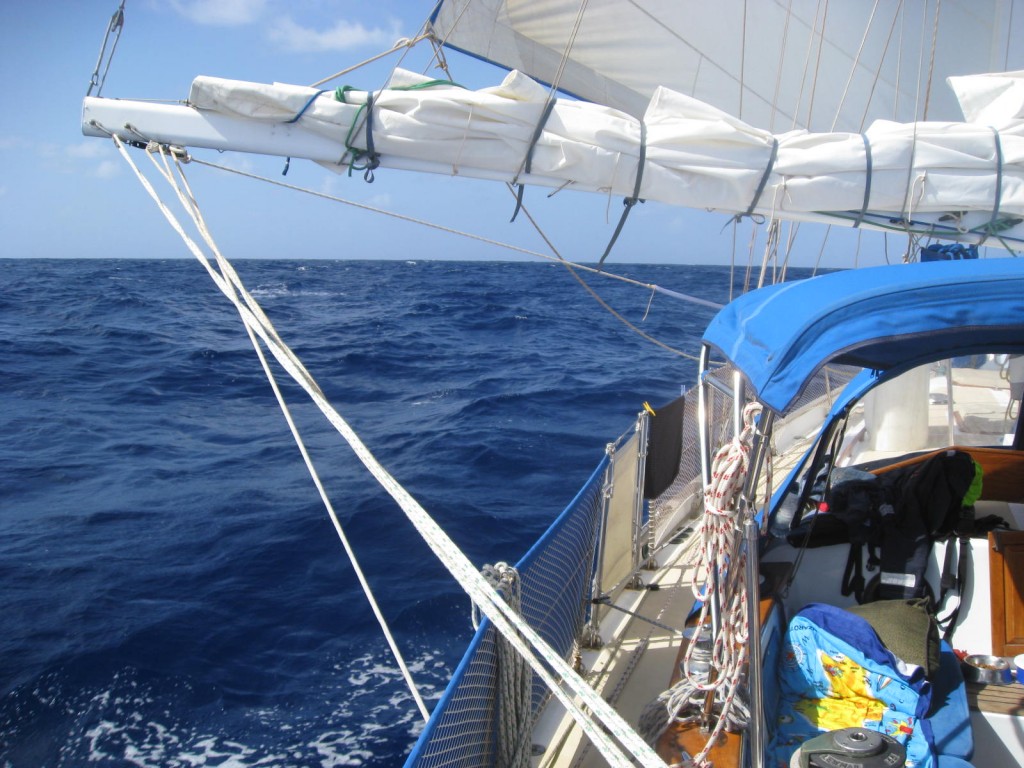
Day 9
The boom (poor man part) is used as a pole. The main sheet and a preventor are used to hold it static. The foresail sheet runs through an ‘opening’ block on the end of the boom. The sheet can run freely so the foresails can be reefed but the boom stays static.
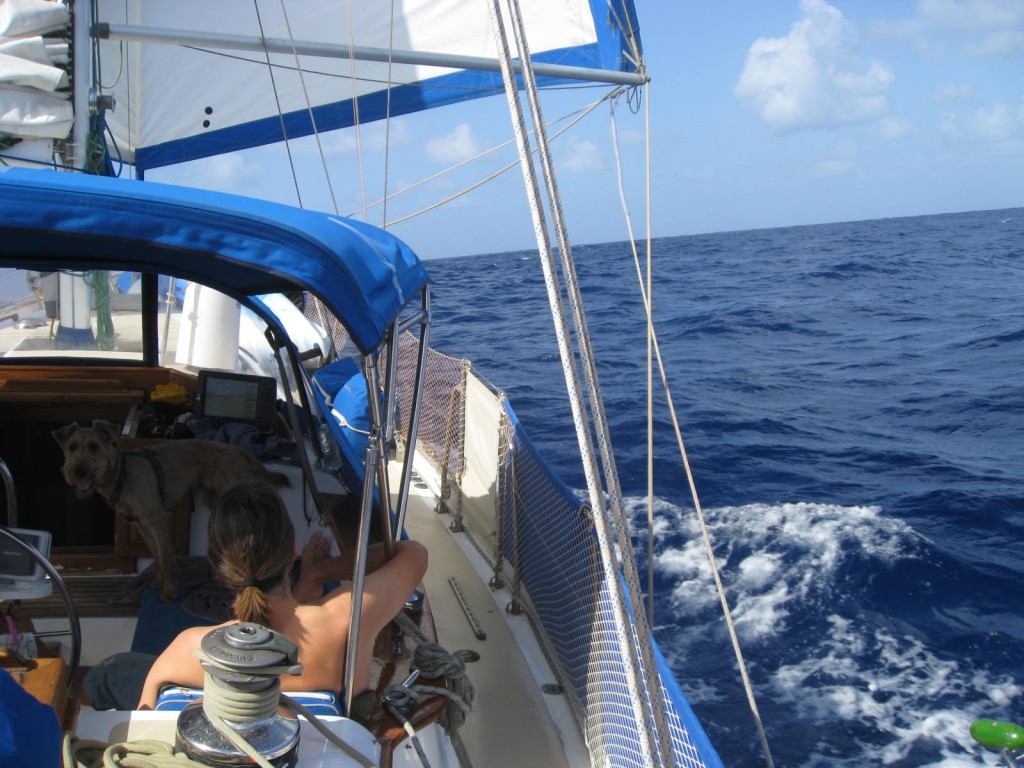
Day 9
The pole is set up as usual. Clipped onto the foresail sheet with a halyard used as a topping lift, a foreward and stern preventor line to hold the pole static. As with the boom, the foresail sheet runs freely so reefing can be done.
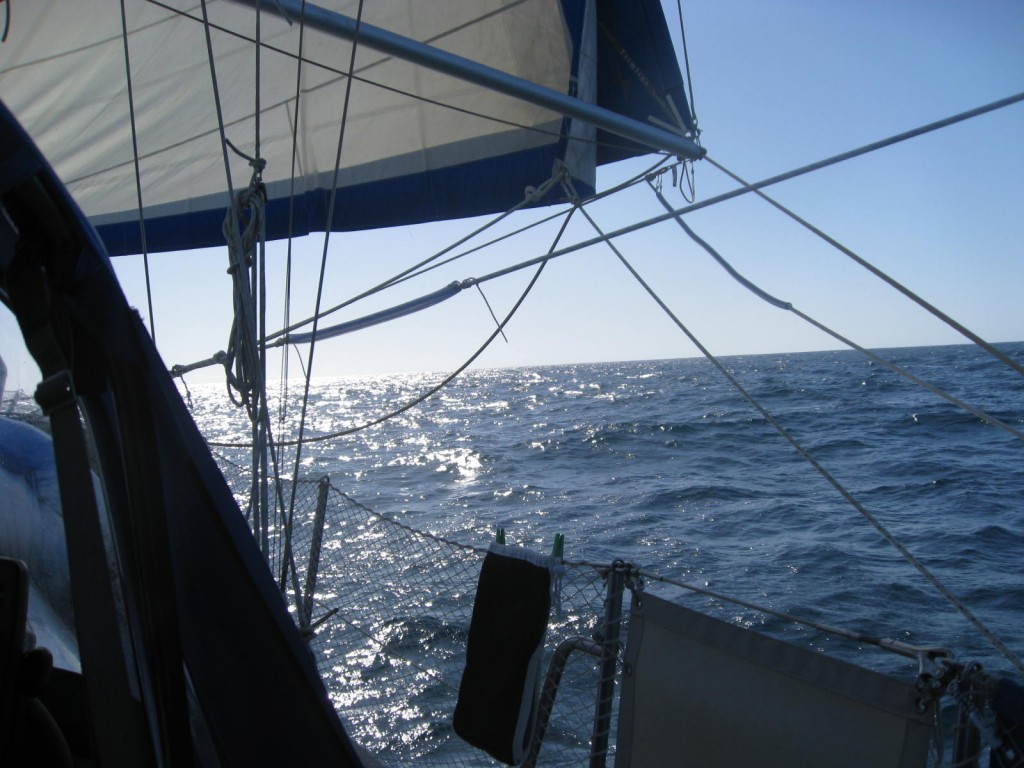
Day 3
The wind was not co-operating so we needed to put both the fore sails on the same side to sail abeam
This was our first trans-Atlantic passage and we had very fair weather.
We are not ‘professionals’ and people make the passage regularly with ‘what ever’ they have…..even rubber dinghy and wind surfers!
But as a boring ‘cruiser’, who likes creature comforts, here are a few bits we hope other cruisers planning the passage will find helpful.
Highlights
*Seeing whales and dolphins
*Good fishing days
*Swimming in the middle of the Atlantic
*Getting great emails from everyone to encourage us on and amuse us.
*Making landfall at dawn with Bob Marley playing.
Low Points
*The boredom that set in just after half way.
*Some of the very rolly days, especially for the dog.
*The poor fishing mid Atlantic and missing out on good fishing because it was too rough.
Technical Items
*Twin head sails.
We were really happy with the twin sail arrangement.
Positive- good sail area
-easy on auto pilot
-easy to reef single handed.
Negative-more strain on your furling gear
-very hard to drop one of the foresails on passage
-wear on your ‘working sail’ if you over lap them to go to beam or forward.
We used the ‘poorman’s rig’ described by Don Street in his guide to the Cape Verdes.
We were really glad we pre-set and pre-marked all our preventers with extra wear guards (water pipes) on the lines.
If we did it again:
We would fit a thicker furling line (we rotated, then replaced ours mid passage), beef up the blocks leading back to the cockpit (we broke two), have a spinnaker pole locked at 120% of the foresail foot, and put ‘lock tight’ on every screw,bolt and fitting on the furling gear.
If we were rich:
We would have both foresails cut to the same size, two 120% poles (instead of using the boom) and have the poles mast mounted for easy deployment.
*Spares, spares and more spares.
Bring what you can fit and afford. You will not regret it. Spares are hard to find along the way and impossible mid Atlantic.
On passage we replaced our furling line, 2 blocks and a bilge pump.
Best Bits of Equipment
*Auto pilot.
We had an electric auto pilot, Setrex, with an octopus hydraulic ram. It never let us down, but did eat electricity.
*Water maker
We had a PUR Power Survivor 35.
It is over 20 years old, and we bought it (like most of our stuff) off ebay.
It is simple, nothing goes wrong, and it is safe dependable drinking water.
We have the manual handle as well….if all goes wrong.
*Solar panels
They make no noise and are zero maintenance.
We had 460W and it still was not enough.
*Wind generator
We had a old KISS generator, but had lots of problems with electrical faults, so it was never working efficiently. We hope to fix it now.
Still worked down wind and most of the anchorages have a good breeze or wind.
*SSB, pactor modem and sail mail
We were able to get weather updates regularly.
It was so great to be able to keep in touch with family and friends.
Friends could look up things on the internet for us and even send us recipes when all our avocados ripened at the same time.
We felt more connected and not so alone.
*Keel cooled 12 V fridge and freezer.
We were able to keep salad stuff in the fridge and slow the ripening of some fruits for later in the passage.
Frozen vegetables and fruit were so much fresher and crunchier then tinned.
We were able to freeze meat, bread and make ice.
We were able to freeze the surplus fish we caught.
*Galley fan. It get so hot in the galley. Just to have a fan moving air is a ‘god send’.
*Universal 12V charger. To charge phones, computers and anything else without turning on the ‘energy eating’ transformer.
*A secure place to sleep in rough conditions or a good sturdy lee cloth for a sea berth. It gets very rough and rolly and you need to get some sleep. You need a safe comfortable place to get it.
Packing and Supplies
*Lots of snack items for night watches. Variety is important. We loved the little min chocolate bars and nuts.
*Plastic egg crates. Cockroaches will lay their eggs in cardboard egg cartons. We used about 12 eggs a weeks in cocking. Turn egg crates over every few days to make them last longer.
*Do hunt down local markets and suppliers for un-refridgerated, usually locally grown, fruits and vegetables. Do not assume it is local…ask. They will last twice as long at sea
*Lots of plastic bowls. Forget eating off of plates, we never could.
*Wide base, non-slip, stainless steel thermal mugs.
*Reusable, sealable water bottles. Have a shaded secure place to mount the bottle in the cockpit for water. This will help you avoid dehydration.
*We hung two sets of mesh netting in the galley for fruit and vegetables. We found that the passage was so rolly that fruits and vegetables rolled and were damaged in the nets. We started only moving a day or twos handy supply into them.
*Mesh shopping baskets (or crates). I wrapped individual items in news paper and put them in crates. If one item went off it did not effect the rest in the crate. I had one full of potatoes, one of onions with garlics and ginger and a final full of fruit and vegetables. I wedged these in one of the unused cabins. I used Lake Land potato and onion bags to bring 1-2 days supply into the galley. Put fruit and vegetables into the nets as needed.
*Try not to buy things in plastic wrapping. Eg. Choose tinned cola instead of bottled, cartons of juice and milk instead of plastic bottled. It is illegal and environmentally damaging to dispose of plastic at sea. See ‘Handy Things’ for how to store plastic at sea.
*Wish we had bought more Canarian oranges, tins of cola, individual juice boxes, tinned fruit and wet wipes.
*Clear plastic zip lock bags. Handy for everything.
Medical Supplies
*Get your EU medical card (If you are a EU citizen). This entitles you to free visits to a doctor.
*We found prescriptions very cheap in the Canary Islands. Doctors will prescribe anti-biotics on request. We showed one doctor the anti-biotics our UK doctor let us have ‘in case of emergency’. He laughed and said it was for children. He gave us a prescription for stronger broad spectrum.
*Stock up on all non-prescription supplies before leaving the UK. Paracetamol, ibuprofen, anti-histamine, decongestant, antiseptic creams, Milton’s, band aids, sun screen and multi-vitamins are all more expensive.
*Dentists are cheaper in the Canary Islands then the UK.
Watch System
We tried, but found the traditional 4 hour watch system too hard to stay awake for. We found that 3 hours at night to be our maximum.
8-10pm/10-12pm
12-3am/3-6am
6-8am/8-10am
We usually stayed awake for the day, but if it was a rough night we had siestas.
Handy Things
*Wet wipes. 101 handy uses.
*Bits of warp. To tie things down or hold them in place..
*Large (5-8L) plastic water bottles. You can not throw plastic over board at sea, so put it inside sealed plastic water and it will not smell. You would be surprised what you can squeeze into them. They also fit in our rubbish bin nicely.
*Tool bag. In a handy place with the basic tools you might need. Screw driver, mallet, alan keys, adjustable wrench.
*Electrical box. With basics to do electrical repairs.
*Duct tape. Need I say more.
*Water storage bottles with a on/off pour spout. We had two 10L containers that fit on one end of our galley counter. We secured this in place with bungy cord. We could use the pour spout to dispense water with out having to lift anything, even in the roughest conditions. We had found pouring difficult early on in the trip. We had two. One full, the other to be filled with the water maker.
*Lots and lots of plastic hooks, shock cord and bridges. You can use these to secure things in place, add extra security to shelves and so much more.
*Head torches and lots of batteries. If you can get, at least one, with variable brightness, you can read on night watch with out ‘seriously’ effecting your night vision.
*A wash basin that fits in your oven. In the rolly conditions, even a lone butter knife makes so much noise. Store dirty dishes in the gambled oven until you can wash them.
*Good sturdy bucket with a warp tied to the handle. You will use this to scoop sea water under way or in port.
*Good size buckets. Those collapsible rubber ones are great. You need 3-4 to do laundry and carry wet and dry clothes. Try to get all the same make so they stack together and take up less roam.
*Pelican water proof case for your camera. This way you can take your camera with you or have it handy in the cockpit with out worrying about it getting wet.
*Clear plastic sealable tupperware boxes. If you get all the same brand and medium size they will take very little room stacked up when empty. Fill them with first aid stuff, toiletries, spares, computer bits and hard drives, open pasta, rice and measured out amounts of flour.
*Stick up plastic shower trays. We found small ones that stuck up with suction cups. Use them stuck in handy places to hold stove lighters, scrubbers and sink pugs, tooth brushes and paste, hand soap dispensers or any thing else that will roll away in rough weather. You can remove them later when you are in port.
*Lots and lots of clothes pegs and one or more containers or bags to hold them.
Getting Things Along the Way
*See above for medical supplies.
*Spares are very difficult to get once you leave the mainland, so stock up.
*Propane is very difficult to get in France, Portugal, Spain and the Canary Islands. You can get camping gas though.
*The cheapest place to by camping gas and associated bottles and valves is Portugal. It is subsidised by the government.
*Everything is cheaper where there is competition. Learn the lost art of bartering!
Creature Comforts
*Binimi cover. We would have ‘baked’ if we could not have found shade in the afternoon heat. We also used zipper on mesh sides that hooked onto the top of the guard rails to help keep the cockpit cool.
*Dodgers around the stern and back sides of the boat. Helped to keep our cockpit a little drier.
*Cockpit cushions. Walking around was difficult so you end up sitting a reading a lot. Cushions were nice for our bums and backs. Canvas was water proof while breathable on skin. Do get them secured into place as you get rolled about a lot.
*Lots of different things to do in rough weather. If you are like me you will get bored with just one thing to do for 3-4 weeks. Books (kindle), sudoku, work search, crossword, music, audiobooks or anything you can do sitting on a rolly boat.
Worries
*Strain on the furling gear with the twin sail arrangement. Our rigging was new, but we were unsure how much force the old furler could take.
*Personal injury so far from medical help. We wish we had taken a medical course and had a better stocked first aid box.
*Man overboard. And every worry associated with it.
*Bad weather. We did not think the boat would sink, but bad weather means horrible discomfort, greater likelyhood of gear failure and greater chances of injury or an accident.